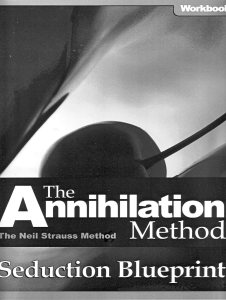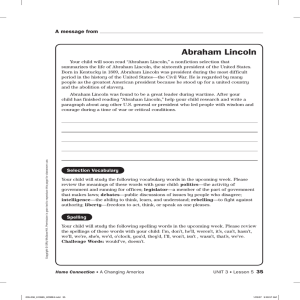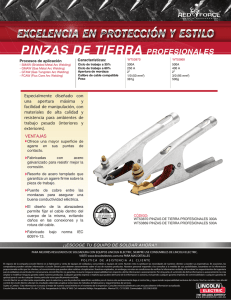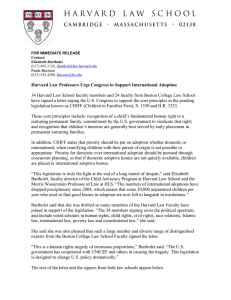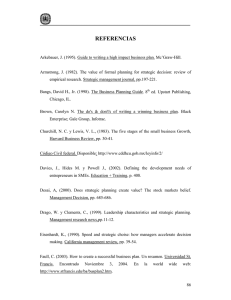Classic harvard Cases - Harvard Business School Working Knowledge
Anuncio
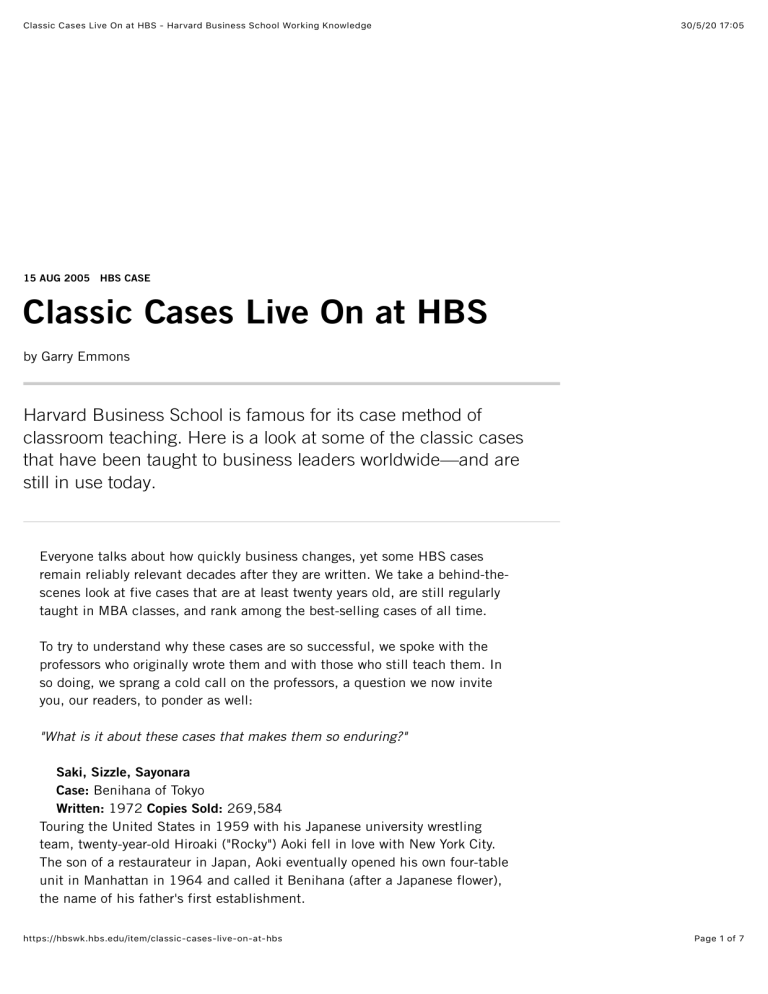
Classic Cases Live On at HBS - Harvard Business School Working Knowledge 30/5/20 17)05 15 AUG 2005 HBS CASE Classic Cases Live On at HBS by Garry Emmons Harvard Business School is famous for its case method of classroom teaching. Here is a look at some of the classic cases that have been taught to business leaders worldwide—and are still in use today. Everyone talks about how quickly business changes, yet some HBS cases remain reliably relevant decades after they are written. We take a behind-thescenes look at five cases that are at least twenty years old, are still regularly taught in MBA classes, and rank among the best-selling cases of all time. To try to understand why these cases are so successful, we spoke with the professors who originally wrote them and with those who still teach them. In so doing, we sprang a cold call on the professors, a question we now invite you, our readers, to ponder as well: "What is it about these cases that makes them so enduring?" Saki, Sizzle, Sayonara Case: Benihana of Tokyo Written: 1972 Copies Sold: 269,584 Touring the United States in 1959 with his Japanese university wrestling team, twenty-year-old Hiroaki ("Rocky") Aoki fell in love with New York City. The son of a restaurateur in Japan, Aoki eventually opened his own four-table unit in Manhattan in 1964 and called it Benihana (after a Japanese flower), the name of his father's first establishment. https://hbswk.hbs.edu/item/classic-cases-live-on-at-hbs Page 1 of 7 Classic Cases Live On at HBS - Harvard Business School Working Knowledge 30/5/20 17)05 Watching Americans dine out, Aoki had concluded that they "enjoyed eating in exotic surroundings but were deeply mistrustful of exotic foods." He also determined that labor cost and availability was the key problem in the U.S. restaurant business and that eliminating the conventional kitchen could address that. From these fundamental observations, he soon developed a chain of restaurants based on a novel concept. Built with authentic interiors and fixtures imported from Japan, the restaurants featured a working chef at every table, flamboyantly preparing and grilling familiar American foods such as shrimp, beef, and chicken ("No slithery, fishy things," Benihana ads promised). After reading in a trade publication about Benihana's innovative and efficient use of labor and layout to lower costs and facilitate customer turnaround times, Professor Earl Sasser produced the Benihana case in 1972 with research associate John Klug (HBS MBA '72). Recalls Sasser, "The idea was to view process analysis—a concept we taught in Production and Operations Management—in a setting that didn't involve steel mills, printed circuit boards, or sorting cranberries. Students got to see the design of a system, linked together in a production chain, that maximized output." Klug admires the way Aoki took command of a key variable in restaurant management: table turnover, or "turns." "Rocky made the restaurant a theater, with the chef as the star of the show," Klug says. "When the meal was over, the chef bowed, the performance ended, and the delighted diners got up to leave, all in about one hour." More than thirty years later, Professor David Upton makes Benihana the very first case he teaches in his Technology and Operations Management course (POM's successor). Explains Upton, "After Benihana, the students' eyes are opened to what process flow is, and they see it everywhere they go." He adds that "my favorite part of the case is the bar operation. Since people are seated in groups of eight, often with strangers, it sometimes helps to have them drink a little bit first—but not so much that they become crude or miss their exit cues when the meal is over. Careful design of the bar area helps control all that. "As for my students," Upton concludes, "they really get a kick out of the fact that, at a Benihana restaurant, the parts arrive, they lubricate themselves, and then they get themselves processed." You Get What You Pay Them Case: Lincoln Electric Company Written: 1975 Copies Sold: 284,826 With a tradition of innovation and technological leadership, the Lincoln Electric Company of Cleveland, Ohio, was the world's largest manufacturer of arc-welding products when this case was written in 1975. The firm owned a https://hbswk.hbs.edu/item/classic-cases-live-on-at-hbs Page 2 of 7 Classic Cases Live On at HBS - Harvard Business School Working Knowledge 30/5/20 17)05 number of patents and was the inventor of the first portable welding machine. But it stood out in other ways, too. While Lincoln, a nonunion shop, offered no benefits, it provided guaranteed employment, had an employee stockownership plan, and was notable for its egalitarian worker-management culture. However, the company was best known for its compensation system, paying its workers on a piecework basis, coupled with bonuses based on company revenues. Although this often resulted in average annual pay for Lincoln workers that was more than double competitive wages, the company was still a low-cost producer. HBS professor emeritus Norm Berg, who developed the case along with research assistant Norman Fast (HBS DBA '77), was at the time course head of Business Policy, the School's required general management course. Recalls Berg, "We had lots of cases involving new and 'more advanced' approaches to corporate strategy, company organization, worker morale and productivity, and so on. "I wanted to find a successful, well-established manufacturing company with a single product line and a clear, consistent approach to those issues." Student reaction to the case has been interesting, Berg notes. Once, during an MBA class attended by Lincoln's president, a student declared that he had high regard for Lincoln but he preferred three-piece suits and executive dining halls to eating in a company cafeteria. A union leader, invited to a discussion of the case at an HBS club in the Midwest, commented, "Lincoln workers receive high pay and job security, and there is no need for a union there. But I'm not worried that there will be a diminishing role for unions, because most of you are too dumb to run your companies that way." AFTER BENIHANA, THE STUDENTS' EYES ARE OPENED TO WHAT PROCESS FLOW IS, AND THEY SEE IT EVERYWHERE THEY GO. — PROFESSOR DAVID UPTON Berg expresses some surprise about the ongoing popularity of this case about an unglamorous product in an obscure industry. "I think its durability comes from the opportunity to discuss the basic management issues it raises—the value of Lincoln's clear and consistent approaches to strategy, organization, and what motivates workers." "Motivation is the key to a high-performing organization, and it's at the core of the Lincoln Electric case," agrees Professor Tom DeLong. In his course Managing Human Capital, DeLong challenges his students' assumptions about incentives, motivation, and compensation by contrasting the Lincoln case and its focus on the worker-as-individual with a case about a successful teams-driven organization that he teaches the day before. https://hbswk.hbs.edu/item/classic-cases-live-on-at-hbs Page 3 of 7 Classic Cases Live On at HBS - Harvard Business School Working Knowledge 30/5/20 17)05 "A small percentage of students are intrigued by and support the complete meritocracy they see at Lincoln," DeLong notes. "But the majority rejects the piecework system, although international students do seem more familiar with it from observing it in their own countries. "As it happens, the Lincoln Electric Company is now a thriving multinational —and its Cleveland plant remains as successful as ever." Good Wrap, Bum Wrap Case: Sealed Air Corporation Written: 1982 Copies Sold: 234,629 In 1971, T.J. Dermot Dunphy (HBS MBA '56) became CEO of Sealed Air Corporation, a fledgling New Jersey protective-packaging company. Under his leadership, Sealed Air soon became known for its quality products and technological innovation. By the time Dunphy stepped down as company chairman in 2000, Sealed Air's sales had reached $3 billion worldwide. When Dunphy arrived at the firm, its signature product, familiarly known as Bubble Wrap but trademarked as AirCap, consisted of a flexible, clear plastic sheet containing regularly spaced air bubbles of uniform size. AirCap cushioning differed from all other bubble products in that the interior of each bubble was coated with saran, which reduced air loss and prevented compression, resulting in greater protection. This saran "barrier coating" had been a key sales point that Sealed Air emphasized to its customers. Low-cost competitors had begun offering an uncoated bubble wrap that threatened to take market share away from Sealed Air. Should the company abandon its exclusive commitment to coated bubbles in order to fend off this challenge? I'M NOT WORRIED THAT THERE WILL BE A DIMINISHING ROLE FOR UNIONS, BECAUSE MOST OF YOU ARE TOO DUMB TO RUN YOUR COMPANIES THAT WAY. — A UNION LEADER Says Robert Dolan, the author of the case and now dean of the University of Michigan's Ross School of Business, "Sealed Air is the perfect case for opening a class with the question, 'What are you going to do?' There's really no wiggle room. After some analytics, you have to choose between 'Yes, introduce uncoated' or 'No, don't.' Over the past twenty years, I have run into that analogous question in hundreds of companies. Should you trade down your product line to broaden the market you serve? These are issues that do not go away, and I think that's what makes the case an enduring one." https://hbswk.hbs.edu/item/classic-cases-live-on-at-hbs Page 4 of 7 Classic Cases Live On at HBS - Harvard Business School Working Knowledge 30/5/20 17)05 HBS assistant professor David Godes now teaches Sealed Air in the secondyear elective Business Marketing. Says Godes, "There are so many different layers to this case but, in particular, it captures two important concepts: reaction to competitive entry and the rethinking of one's entire strategy—and corporate identity—in the face of disruptive events. The key thing to understand is that more than being a small extension of the product line, offering an uncoated product could change the company's entire market capability. And it would mean big changes for the sales force. One thing I like to do in my class is consider how the sales strategy would need to be adjusted in order to succeed with both a coated and an uncoated product." How Much You Asking for that Pile-Driver Pad? Case: Cumberland Metal Industries: Engineered Products Division–1980 Written: 1980 Copies Sold: 197,677 Cumberland, a disguised company, has developed a new "cushion pad" that will improve the pile-driving process, a common activity in the construction of large structures such as bridges and buildings. Piles—heavy beams of concrete, steel, or other material—are pounded into the ground by a large "hammer" attached to a crane. The cushion pad, which sits inside a "helmet" placed between the hammer and the pile, must transmit force while protecting the pile. The new Cumberland pad does this particularly well, and the company believes the product could become an important source of revenue. But how much should the company charge for it? Little is known of the pad's potential market, and there is little data available regarding other variables that would also influence the product's price. "The company's president came to us with the idea for a case because he was perplexed about how to price the new pile driver and hammer pads," recalls HBS professor emeritus Ben Shapiro, who supervised research assistant Jeffrey Sherman (HBS MBA '79) in his preparation of the case. "As it happened, in first-year Marketing, we badly needed a case related to 'value pricing'—pricing a product according to how valuable it is to the customer. "The case also proved useful in dealing with other complex issues related to distribution and market segmentation, two very important issues in marketing," Shapiro continues. "The Cumberland case is timely because the situation and the product are easy to understand, but the decisions to be made are intricate and difficult." "Value pricing is as important an issue today as it was when this case was written," comments Professor Das Narayandas, who has taught Cumberland in first-year Marketing. "For a marketer, fundamental questions include how much of the customer value created can be extracted by the firm and how to justify the price that one sets for the customer. When students learn that a hammer pad basically consists of coiled steel, they often exclaim, 'And I'm https://hbswk.hbs.edu/item/classic-cases-live-on-at-hbs Page 5 of 7 Classic Cases Live On at HBS - Harvard Business School Working Knowledge 30/5/20 17)05 expected to pay thousands of dollars for that?' They come to grips with the idea that physical appearance plays a part in how you price a car, but with an industrial product, it's all about the value you create." Hernias R Us Case: Shouldice Hospital Limited Written: 1983 Copies Sold: 240,911 Shouldice Hospital, a Canadian facility that performs hernia operations only, has developed procedures to maximize surgical success rates, save patients money, and speed their recovery in a friendly, noninstitutional environment. The hospital's advertising consists of word of mouth, and Shouldice's popularity is such that former patients ("alumni") return by the hundreds for reunions. The hospital has a backlog of prospective patients awaiting surgery, and the case sets forth various proposals for increasing its capacity. In considering change, the importance of the organization's close-knit culture— built around quality service, attention to patients, and an attractive work environment for doctors and staff—must be taken into account. BY SHOWING THE POSITIVE IMPACT OF MAKING HEALTH CARE MORE CONSUMER-ORIENTED, SHOULDICE HAS HELPED RECRAFT THINKING ABOUT THE FIELD. — PROFESSOR REGINA HERZLINGER "I read a short magazine article about Shouldice in 1982, and it nicely illustrated excellence in the delivery of a service," explains the case's author, HBS professor James Heskett. "I knew we had a good story, and when I learned that Shouldice management had discussed the capacity question, it was clear we had a core issue that could be teachable in the classroom." (Indeed, aspects of the case were sometimes a bit too gripping for a few students: Heskett recalls that after a television report on Shouldice became a regular part of the case's classroom presentation, students would occasionally faint during some of the surgery scenes.) Heskett says studying Shouldice helped him conceptualize the strategicservice vision that he and HBS colleagues would develop into a framework for success for service firms. "The case endures," he declares, "because the mission of Shouldice has remained constant and because Shouldice has inspired other focused medical ventures. More broadly, it is a dynamic illustration of concepts still critical to service-management success." Like Heskett, HBS professor Regina Herzlinger cites Shouldice as an important intellectual stimulus, helping her develop innovative ideas about consumer-driven health care. "By showing the positive impact of making health care more consumer-oriented, Shouldice has helped recraft thinking https://hbswk.hbs.edu/item/classic-cases-live-on-at-hbs Page 6 of 7 Classic Cases Live On at HBS - Harvard Business School Working Knowledge 30/5/20 17)05 about the field," Herzlinger says. In her course Innovating in Health Care, she uses the case to illustrate a medical "focus factory," emphasizing that focus without Shouldice-like consistency and execution is not enough. One of her favorite aspects of the case is what happens after surgery. "Shouldice believes that walking early and often is a key to postoperative recovery," Herzlinger observes. "So there are no bathrooms, nor meals served, in the rooms. You have to walk to satisfy your basic needs. Your recovery— indeed, the entire Shouldice experience—is advanced by such fundamental inducements, as well as by attractive ones, such as the beautifully landscaped grounds that encourage patients to be ambulatory." NOTE: "Copies Sold" are totals as of December 1, 2004. BROWSE POPULAR TOPICS LEADERSHIP ENTREPRENEURSHIP https://hbswk.hbs.edu/item/classic-cases-live-on-at-hbs GENDER NEGOTIATION Page 7 of 7
